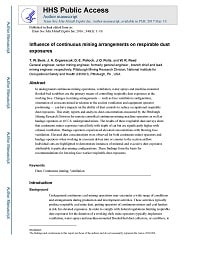Mining Publication: Influence of Continuous Mining Arrangements on Respirable Dust Exposures
Original creation date: March 2016
Authors: TW Beck, JA Organiscak, DE Pollock, J Potts, WR Reed
In underground continuous mining operations, ventilation, water sprays and machine-mounted flooded-bed scrubbers are the primary means of controlling respirable dust exposures at the working face. Changes in mining arrangements — such as face ventilation configuration, orientation of crosscuts mined in relation to the section ventilation and equipment operator positioning — can have impacts on the ability of dust controls to reduce occupational respirable dust exposures. This study reports and analyzes dust concentrations measured by the Pittsburgh Mining Research Division for remote-controlled continuous mining machine operators as well as haulage operators at 10 U.S. underground mines. The results of these respirable dust surveys show that continuous miner exposures varied little with depth of cut but are significantly higher with exhaust ventilation. Haulage operators experienced elevated concentrations with blowing face ventilation. Elevated dust concentrations were observed for both continuous miner operators and haulage operators when working in crosscuts driven into or counter to the section airflow. Individual cuts are highlighted to demonstrate instances of minimal and excessive dust exposures attributable to particular mining configurations. These findings form the basis for recommendations for lowering face worker respirable dust exposures.

- Analyzing Factors Influencing Struck-By Accidents of a Moving Mining Machine by Using Motion Capture and DHM Simulations
- Dust Considerations When Using Belt Entry Air to Ventilate Work Areas
- Dust Control Handbook for Industrial Minerals Mining and Processing
- Evaluation of Dust Exposure To Truck Drivers Following The Lead Haul Truck
- Impact of Background Sources on Dust Exposure of Bag Machine Operator
- Impact on Respirable Dust Levels When Operating a Flooded-bed Scrubber in 20-foot Cuts
- A Review of Occupational Silica Exposures on Continuous Mining Operations
- Technology News 463 - Machine-Mounted Continuous Respirable Dust Monitor
- Technology News 509 - A New Method to Clean Dust From Soiled Work Clothes
- Technology News 539 - Identifying The Benefits Of Engineering Noise Controls Through A Business Case